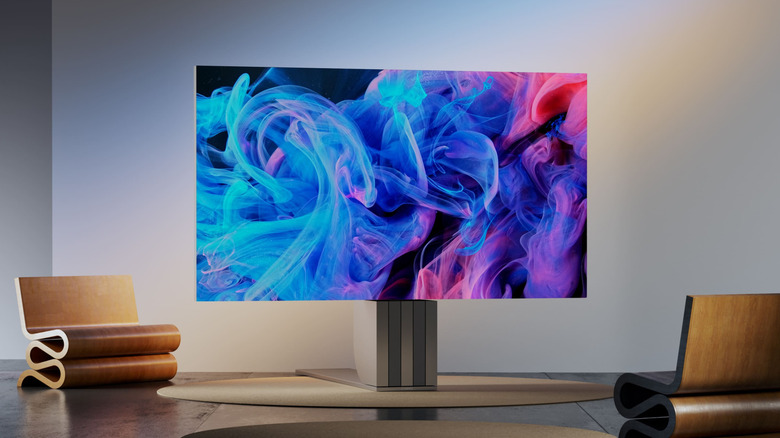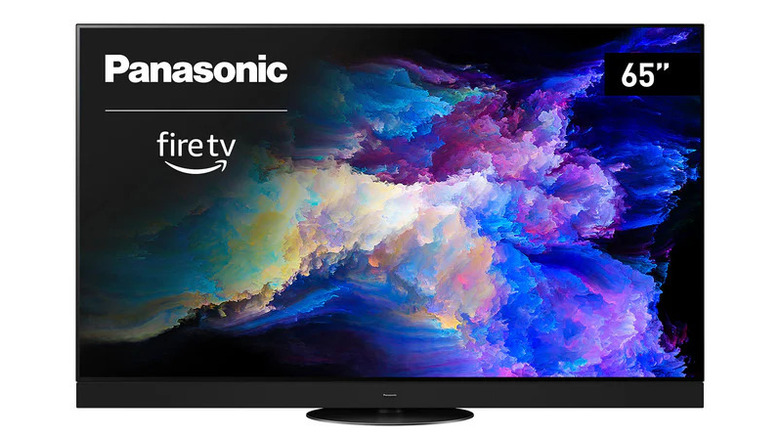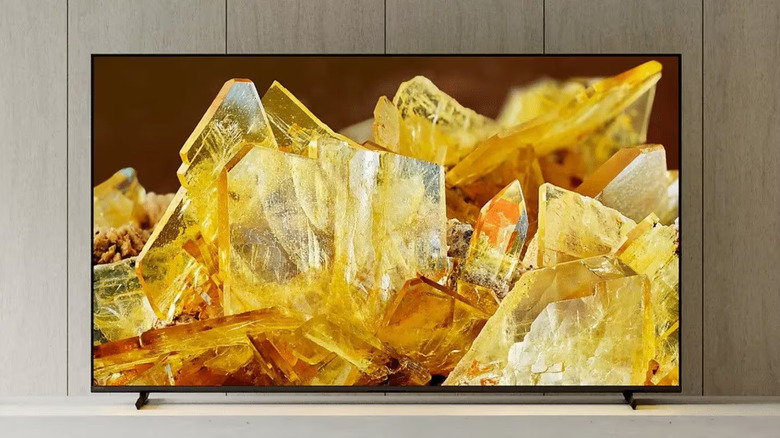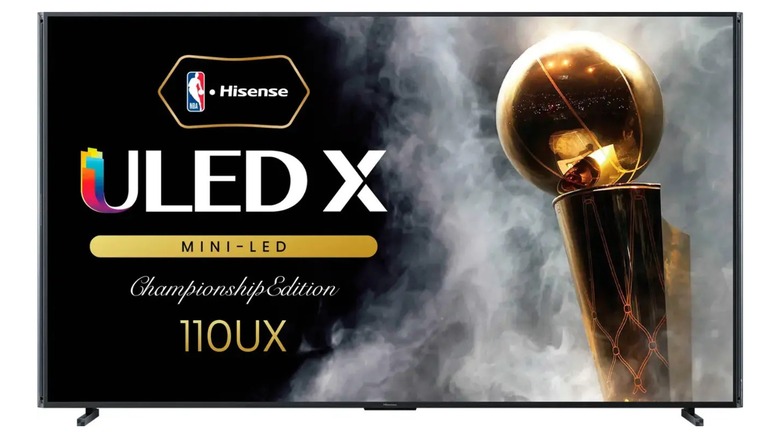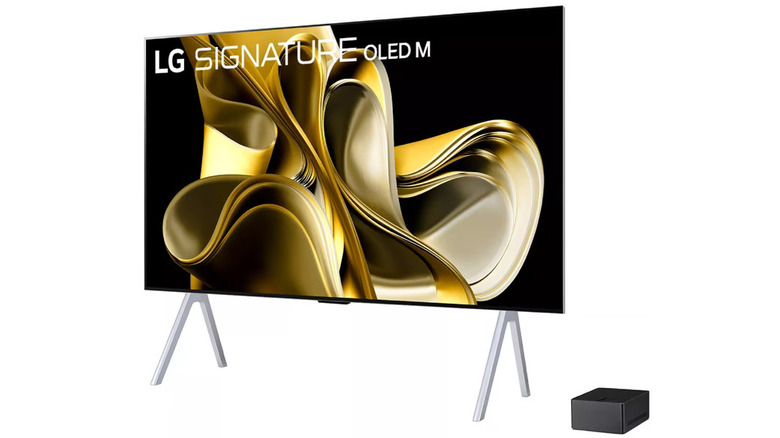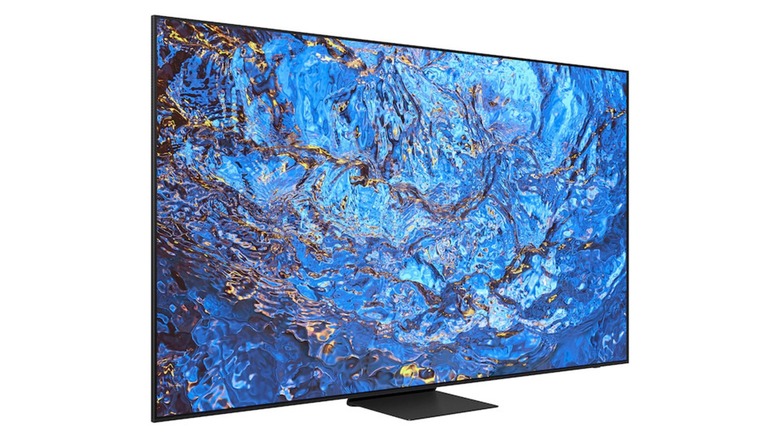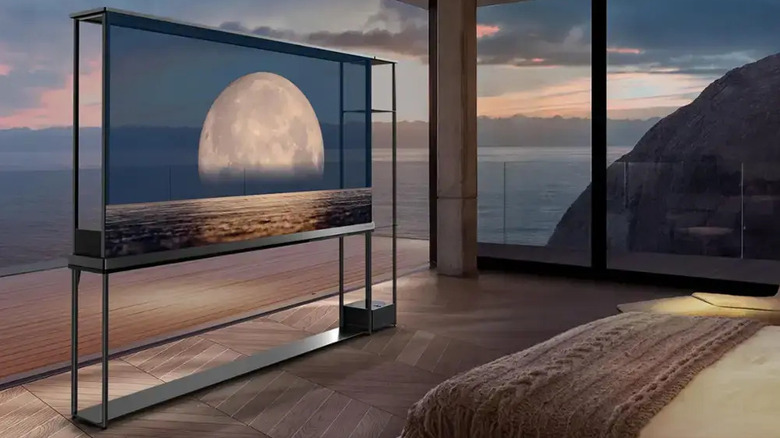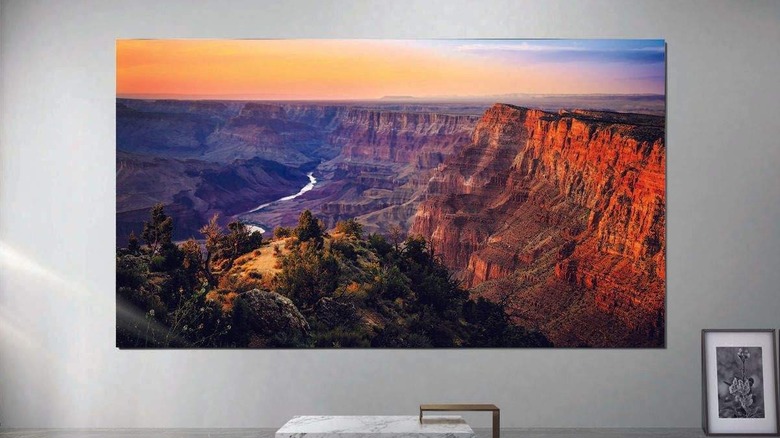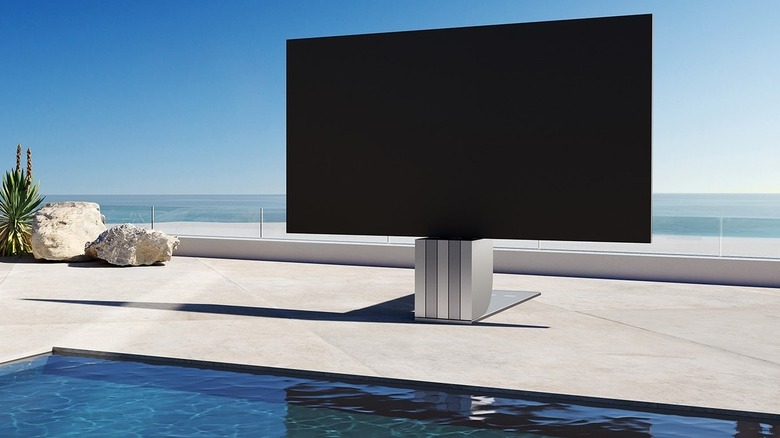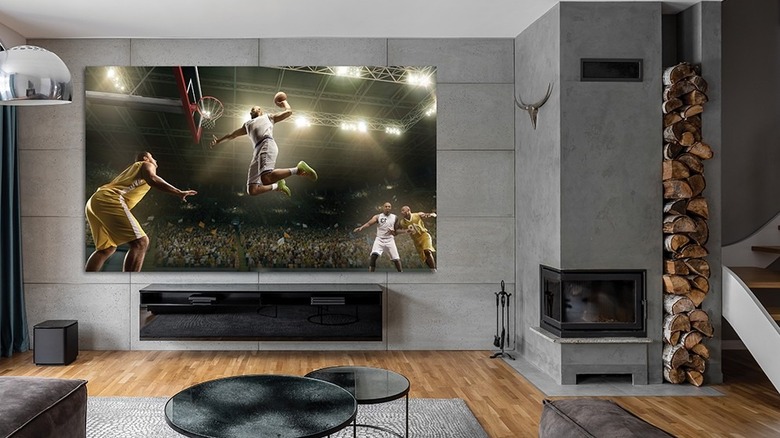11 Of The Most Expensive TVs For Sale In 2025
TVs are more affordable than ever. In the old days, widescreen TV sets weighed a ton and cost a fortune. These days, everyone and their grandmother has at least one widescreen TV, with jumbo-sized LCD screens selling for just a few hundred dollars.
However, discerning customers know there's more to a TV than just its dimensions. They know the difference between LCD, OLED, QLED, and Micro LED. They might even mourn the death of Plasma back in 2014. It was an innovative, if unwieldy, technology, and its devoted fanbase insists it never got the chance to reach its full potential.
In 2025, the options for TV buyers are nearly endless, but beyond the standard range of consumer sets, there exists another world — the world of luxury. For the truly premium television enthusiasts, only the best will do, and the best always comes at a cost. Ranging from $3,000 to over a million bucks, the TVs on this list are the most expensive money can buy, but as the old saying goes — it pays to buy the best. Here are the most expensive TVs on sale right now.
Panasonic OLED Z95A Series
Compared to some of the other screens on our list, the Panasonic OLED Z95A is a reasonably affordable piece of hardware. The 65-inch screen retails for $3,199, which is probably outside the range of most reasonable people. Still, for hardcore A/V enthusiasts, this might be a justifiable, if still luxurious, purchase.
So, what makes this television set worth it? In addition to its suite of Smart TV functionality (including Fire TV OS, Amazon Alexa integration, and Apple AirPlay), the Z95A has surprisingly high brightness for an OLED screen, thanks to its MLA (Micro Lens Array) system. It also supports 4K imagery at 144 HZ, which makes it a great choice for gamers and fans of live sports.
While most cinephiles will want to buy an additional sound system for maximum impact, this TV features a built-in 5.1 soundbar, which will do in a pinch, or if there's simply not enough space in your media room to fit a big speaker setup. For most consumers, the Panasonic Z95A represents the top of the line, but when it comes to the audacity of luxury, it's just the beginning.
Sony Bravia XR X90L
The Sony BRAVIA line of TVs has been around since 2005, delivering Sony's signature brand of quality and affordability, but with options to go bigger, better, and — of course — more expensive. Enter the Bravia XR X90L, which boasts a Full Array LED screen for maximum brightness. Full Array LED offers a more affordable alternative to OLED, but the technology lacks the color depth of the X90L's OLED counterpart, the OLED Bravia 8.
However, the OLED 8 only goes up to 77 inches, with that premium model retailing for $3,199. On the other hand, the X90L features more size options, going up to an impressive 98 inches. This plus-sized model costs $6,199.99, which puts it well outside the range of most consumers. Still, for those looking for a fair middle ground, the 55-inch version costs only $1,699, a much more affordable option than its OLED competitor.
Hisense 110-Inch Class Mini-LED Premium ULED X Series
Now that the quasi-affordable TVs are out of the way, it's time to take a look at televisions most of us will never be able to afford — at least not while maintaining a reasonable degree of responsibility. To that end, look no further than the 110-inch UX Series 4K Mini-LED ULED from Hisense. While the 98 inch model costs a cool $5,000, the 110 inch version retails for $15,000.
So, what makes this TV worth $15,000? Well, aside from the ability to brag to your friends about spending $15,000 on a TV, this 4K screen boasts a 144hz refresh rate and full array local dimming for strong contrast while maintaining brightness levels that OLED screens simply can't match. It also features Hisense's proprietary Hi-View Engine X technology, which uses AI to optimize contrast and detail. Many A/V enthusiasts pride themselves on their personal calibration skills, but it never hurts to have a little help in the form of custom tech.
On top of all that, owners of the Championship Edition gain access to the x110 Champions Club, which provides NBA-related exclusives. While that has nothing to do with the TV itself, it's certainly a value incentive if you really love basketball.
LG Signature 97-Inch OLED M
When it comes to image clarity, input delay, and wide viewing angles, you can't beat a high-quality OLED screen, especially if that screen supports HDR. While the brightness might not be able to match LCD or LED panels, the superior black levels and aforementioned other advantages more than make up the difference. While there are plenty of OLED screens available for under $2,000, this is the wrong SlashGear article for that.
LG's M3 Series starts at $4,000 for the 77 inch model, but for those who adhere to the mantra of go big or go home, there's no choice but to go for the 97-inch version, which retails for $20,000. At this size, the strength of OLED — which offers significantly improved motion blur — really comes into play.
For people who like to play with fire and sit too close to the TV, older and brighter LCD or even Micro LED displays can cause motion sickness or headaches because of the blur. With OLED technology, the blur is severely reduced. Not quite to the level of old Plasma TVs, mind you, but those sadly don't really exist anymore. As an added bonus, it also wirelessly connects to HDMI devices via a Zero Connect Box, which cuts down on pesky crossed wires.
TCL 115-Inch QM89 QLED 4K Smart QD-Mini LED TV
When it comes to mammoth-sized displays, OLED technology is a bit too expensive to sustain at sizes above 70 inches for any kind of reasonable price. Thus, when going for a super-sized screen, alternatives must be sought out. QLED tech is often more affordable, and the TCL QM8 LED 4K Smart QD-Mini LED retails at under $1,000 for the 65-inch version. However, the price rises exponentially as the size goes up, with the TCL 115-Inch QM89 QLED 4K Smart QD-Mini LED selling for an eye-popping $20,000.
While OLED stands for Organic Light-Emitting Diode, QLED stands for Quantum Dot LED TV. As fans of sci-fi movies know, Quantum dots are microscopic crystals that improve the color depth and longevity of a typical LCD display. Still, when pitted head-to-head, OLED tech generally outperforms QLED screens. Ultimately, it's up to each customer to decide whether they want to spend more on a potentially smaller, but superior OLED display, or spend less on a larger QLED display that might not have the advanced color picture quality of an OLED.
98 Class Samsung Neo QLED 8K QN990C
Samsung's 98-inch QLED display is the first television on this list to feature an 8K display, and it's got a price to match — it costs a downright shocking $40,000. Unfortunately, there isn't a whole lot of content out there that supports 8K in 2025, as 4K seems to be the standard for the time being. To compensate, the Neo QLED 8K QN990C features what Samsung calls the Neural Quantum Processor 8K, which upscales content from 4K and 1080p up to 8K.
On top of its immense size and AI enhancements, the QN990C also includes the Q-Symphony, which lets users pair the TV's built-in speakers with a Samsung soundbar to operate as a single audio system. So many TVs feature audio systems that go unused in favor of soundbars or more complex surround sound systems, so it's nice to have a TV that incorporates both external speakers and the unit's own internal speakers to create an elevated audio experience.
LG Signature 77 Class OLED T
The priciest OLED on this list is LG's Signature OLED T, but OLED technology isn't the main selling point of this screen — nor is its size, which is pretty typical by big TV standards, at least). It's the T part of the SIGNATURE OLED T that's been raising eyebrows, as the T stands for transparent.
This screen has a filter that can be raised or lowered. When raised, it looks just like a regular premium OLED screen, but when lowered, the display becomes completely transparent, which makes the TV feel like something from a science fiction movie. Then again, it's hard to think of any situation where someone would actually want to watch a movie or play a video game on a transparent TV, but if you're willing to pay $59,000 for a TV, then you'll probably want to use all of its features.
Despite all the hubbub over the transparent screen, the SIGNATURE OLED T boasts another impressive feature, which is that it's wireless. Instead of plugging HDMI cables into the TV directly, they plug into a nearby box that wirelessly transmits to the TV with a range of up to 30 feet. That should help with wire clutter, especially for video game enthusiasts with multiple consoles.
Samsung The Wall
Samsung's The Wall made headlines when it was first announced in 2018 thanks to its provocative name and outrageous dimensions. The Wall comes in two sizes, 110 inches and 146 inches. Curiously, as of this writing only the 146 inch version has an option for a 4K display on the Samsung website. It's hard to imagine a 2K image blown up to fit a 146-inch monitor would look very good, but the sheer shock value of a 146 inch screen might overcome the lack of pixel density.
The 2K version of the 146 incher costs $92,000, while the 4K version costs a whopping $219,000. These are the commercially available units, but the wealthiest of customers can fork out even more money for an 8K version that measures a staggering 292 inches.
The Wall can hit a peak brightness of 5,000 nits, well beyond the capabilities of any OLED TV on the market today. The set's microLED technology enables this powerful level of brightness. The 146 inch 4K version weighs 352 pounds, supports HDR10 for enhanced color and contrast, and is rated for 150,000 hours of LED life. The screen has built-in stereo speakers, but if you can afford a TV bigger than a New York City studio apartment, you can probably afford a fancy audio setup to go along with it.
Samsung 114 Class MICRO LED Smart TV
If you've got $150,000 burning a hole in your pocket and it's time for a new television, maybe it's time to invest in Samsung's 114-inch MICRO LED Smart TV. This screen uses the same micro LED technology as The Wall and the rest of the entries on this list, which allows for superior brightness over contemporary OLEDs. It's hard to justify spending $150,000 on — well, just about any piece of consumer electronics, really — but if you've got the money to burn and you're so inclined, then this is one of the best TVs money can buy.
Like other high-end TVs, Samsung's MICRO LED Smart TV features an AI processor that upscales sub-4K content into 4K resolution, as well as built-in 3D audio speakers. For those who don't have multiple monitors or simply want to channel the far-flung future of 2015 as seen in "Back to the Future Part II," the TV also features 4Vue, which allows up to four different HDMI sources to be displayed at once. Since the TV is 4K, this means each of those sources will display at a full HD 1080p resolution.
C Seed N1
Did you ever wonder what it would be like to have a TV that was also an Autobot from Transformers? Look no further than the C Seed N1, a Micro LED display designed to be used outdoors. At a glance, the TV is hidden in plain sight as an innocuous sculpture that could easily be mistaken for a nondescript piece of modern art. However, with the push of a button, it unfolds, expands, and reveals its true form, a massive, 165-inch screen that's perfect for outdoor viewing — or indoor viewing, if you're lucky enough to have the space for it!
Still, considering the high maximum brightness of Micro LED technology, outdoors might be the best place to make use of that technology. This means that it's relatively unaffected by ambient light, even if that ambient light comes from the Sun. This screen goes up to 4,000 nits and features a built-in audio system that simulates a 9.2 surround sound setup, as well as a 3,840Hz refresh rate, which should be great news for gamers obsessed with maximizing their frame rates.
If you want to get the 165 inch version, it will set you back an absurd $300,000. If you're a real cheapskate, though, you can purchase the 103-inch version for only $110,000, which is chump change by comparison.
Planar Luxe MicroLED 4K
There are TVs, and then there are status symbols. The Planar Luxe MicroLED 4K television starts at $406,000 for the 108-inch version, but the mammoth 217-inch version costs $1,595,000. What on Earth could possibly make a TV worth over a million and a half dollars? The size speaks for itself to a degree, and it supports all the bells and whistles, from 8K support to HDR, and is powered by microLED technology that has grown to rival OLED with its superior brightness and longevity.
The Luxe designation for this TV denotes its luxury sensibilities, and you don't get much more luxurious than a TV bigger than an elephant. Based in Oregon, Planar doesn't just sell these screens to consumers, but works with specialists to make sure that everything is done properly, every step of the way, from installation to post-purchase support.
In the event that you buy a Planar Luxe TV, you're not just buying a screen — you're buying the centerpiece of your media-based life for the foreseeable future.
